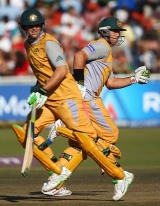
|

Australia have been dismissive of the tournament ... while looking ominously good as contenders
© Getty Images
|
|
Ten breathless days of non-stop action are behind us and we have one whole day to pause and ponder before the semi-finals. Here are some random thoughts, a few borrowed from colleagues and friends.
It's not a nice thing to say, but South Africa choked again. India deserved to win because they batted grittily, bowled decently, and fielded sensationally; but with ten guys who can bat, South Africa should have got 126. They needed just over a run a ball off the last five with five wickets standing.
India are surprise semi-finalists. They came into the tournament with only one Twenty20 international behind them, and without three of their leading batsmen and their best bowler. But their progress shows what energy and youth can accomplish. Who would have thought their bowling and fielding would win them a match? Dinesh Karthik's catch was stunning, and Rohit Sharma's run-out of Justin Kemp more so. Is it a coincidence that India have been involved in three of the most exciting matches so far? The bowl-out against Pakistan was a shame, though.
Six-hitting is spectacular, but it can be dull when it becomes routine.
It's no coincidence that most of the best matches have been those where the bowlers have been in the game.
How different is Twenty20 from one-day cricket in terms of actual play? On the evidence of this tournament, not a lot. We have seen no new strokes, no new balls, and ambidextrous fielders are still not in sight. The main difference, as far as batting goes, is in the mind. Batsmen seem to be scoring much faster by playing the same strokes, just more often.
Why is it that 30 off the last three overs seems more gettable in this format? After all it's the same rules, and teams usually hold their best bowlers back for the last.
What's the par score in Twenty20? Perhaps 160, the equivalent of 250 in one-day cricket. One hundred and eighty is stiff, and a batting team can feel reasonably safe with 200. That said, England got to 200 chasing 219 the other night. But the question is, would they have got that much had they been chasing 200? The exception here would be South Africa in a knock-out match; then 150 might be enough.
Sri Lanka have broken the 250 barrier in international Twenty20. How long will it be before we see a score of 300? I'll stick my neck out: it will be before the 500 barrier is broken in one-day cricket.
 What's the par score in Twenty20? Perhaps 160, the equivalent of 250 in one-day cricket. One hundred and eighty is stiff, and a batting team can feel reasonably safe with 200
What's the par score in Twenty20? Perhaps 160, the equivalent of 250 in one-day cricket. One hundred and eighty is stiff, and a batting team can feel reasonably safe with 200
 |
But Yuvraj Singh's 12-ball 50 will take some beating. The good thing about Yuvraj's sixes was that it was a proper batsman hitting proper shots against a proper bowler. And they were hit all around the wicket. Okay, there was one mishit, but we'll take that.
Given that bowlers are so discriminated against in this format, why didn't Brett Lee's hat-trick, the first in Twenty20 internationals, feel that special? Is it because it meant so little in the context of the match?
There have been only three slip catches in the tournament so far. Paul Collingwood caught by Justin Kemp, Steve Tikolo by Mahela Jayawardene, and Karthik's catch last night. You wonder if the captains have been a bit too eager to get rid of the slips, understandable though the impulse may be.
Plenty of catches have been taken, some spectacular, but plenty have dropped too. In general the fielding has been below par. Twenty20 was expected to raise the bar.
Once again England have pioneered a game and been left behind in it. Not to have won a single match in the second round must hurt. All of their Twenty20 specialists flopped: Jeremy Snape didn't belong, Dimitri Mascarenhas is a one-dimensional cricketer, and Chris Schofield was found out after one match. Only Luke Wright seems to have a future. By the way, where was Ian Bell?
A short World Cup had seemed a great idea before the tournament began. Perhaps it still is, but even if you adore Twenty20, three matches a day can be too much of a good thing.
Also, three games a day means a early start to the first game, which makes it, already a bit like a lottery, even more so. It's great that bowlers are in with a chance in the nippy, early-morning conditions, but in a 20-over game that's too much of an advantage to the team bowling first.
South Africa has been a great choice for the venue of the first international Twenty20 tournament. It is a country where interest in Test cricket has been dying. Twenty20 is a good way to get crowds back to the grounds. A pity that they have been knocked out, though.
Newlands is among the prettiest Test grounds in the world, the others being , in no particular order, the Adelaide Oval, Trent Bridge, and the Asgiriya Stadium in Kandy.
The most audacious batting in the tournament has come from the Bangladesh batsmen. Also the most foolish. Twenty20 should have suited them, but once again Bangladesh flattered to deceive. They can beat the top teams but only about once every ten matches. For Mohammad Ashraful, the equation is even worse: he seems to produce a sensational innings once in every 15 visits to the crease. A distressing waste of talent. As a team they are going nowhere.
Apologies to Monty Panesar but Daniel Vettori is the best left-arm spinner in the world, in any form of the game. He just seems to know where his fielders are; when he has been hit, it is often for a single. He and Stuart Clark have been the only bowlers to have kept their dignity intact. Glenn McGrath can't be replaced, but Clark's success is evidence that any player who comes through the Australian system will be good enough.

|

Sorry Monty, Daniel Vettori is the best left-arm spinner in the world on current form
© Getty Images
|
|
I am not much of a fan of the free hit - batsmen don't get penalised for similar indiscretions; say, for playing and missing - but it's remarkable how the fear of the free hit has reduced the number of no-balls. Will a similar penalty see the number of wides cut down? Perish the thought.
It's equally remarkable how few free hits are taken full advantage of. Here's a stat: only 12 of the 33 free hits in the tournament so far have been hit for a four or a six. Is it because batsmen lose their head in the anxiety to capitalise and end up playing premeditated slogs?
The scoop over short fine-leg may look smart when it comes off, but it's a low-percentage stroke, even more so than the reverse sweep, which is pretty ugly. The yorker two feet outside off stump is most likely to produce a dot ball, but it can go horribly wrong.
Among the "innovations", I have loved the way they measure the sixes. Perfectly meaningless, and we don't even know how they do it or whether they do it right, but who cares. On top of the list is a surprise: Misbah-ul-Haq at 111 metres. But then he has been the surprise of the tournament.
The flip side of being the world's best team is: everybody hates you. The locals have supported South Africa and anybody who plays Australia. The match between Australia and Pakistan at the Wanderers provided a picture of Asian solidarity. Indian and Pakistani flags fluttered together, and soon they were joined by Sri Lankan and Bangladeshi ones.
Australia have been sniffy about the tournament. While some suspect it's because they have been patchy, you can't really disagree with some of their points. The best teams don't always win in this form. But why do we get the feeling that Australia are going to win anyway?
Sambit Bal is the editor of Cricinfo and Cricinfo Magazine



